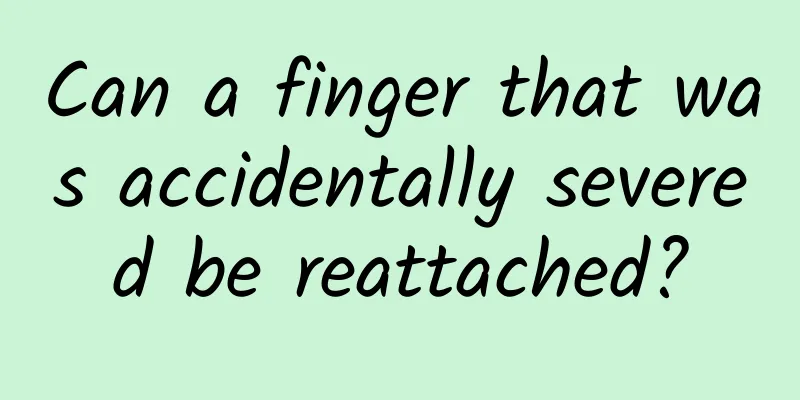Can a finger that was accidentally severed be reattached?

|
This is the 4628th article of Da Yi Xiao Hu Double Eleven is coming soon, and many of you are already on the road of shopping. In medicine, we encounter situations where people lose their hands due to various reasons, which we call "limb amputation." For severed limbs, blood circulation is restored to the severed fingers through suturing, nerve anastomosis, and vascular anastomosis, and the severed parts are fused to restore normal function. After the operation, rehabilitation care is performed to achieve the goal of restoring function. This is a delicate surgery called "severed finger replantation." The history of replantation of severed fingers The history of finger replantation can be traced back to the early 20th century. At that time, French surgeon Jules Emile Pean successfully replanted a patient's severed finger in an operation. After that, Japanese doctor Komatsu promoted finger replantation to Asia and carried out a large number of clinical practices. In the 1950s, American doctor Milton B. Cohen introduced a high-power microscope in finger replantation surgery, which greatly improved the success rate of the operation. Today, finger replantation has become a mature minimally invasive surgical technique and is widely used around the world. What situations in life can cause finger amputation? 1. Cutting injuries caused by sharp objects Cutting with sharp objects such as glass and kitchen knives can cause finger severed. Usually the wound surface of severed fingers is relatively neat, which is one of the common causes of severed fingers. 2. Machine damage Crushing and smashing by machines can cause finger amputation, which usually manifests as multiple fingers and multiple levels of amputation. Fingers amputated by machine injuries are often accompanied by nerve and blood vessel extraction, and the injuries are more complicated and difficult to repair in situ. 3. Electric saw injuries Improper operation of an electric saw can cause finger amputation. Generally, the soft tissue on the wound surface is severely damaged, and some of the damaged tissue needs to be removed during the treatment process. According to the degree of limb amputation, what categories can severed fingers (limbs) be divided into? 1. Complete Disconnection Complete separation occurs when the distal and proximal ends of a severed limb or finger are completely separated, with no tissue connecting them, or only a small amount of severely damaged tissue connecting them, which must be removed before replantation during debridement. 2. Incomplete separation Most of the soft tissue of the injured limb is broken, the cross section has a fracture or dislocation, the remaining connected soft tissue is less than 1/4 of the total tissue of the cross section, and important blood vessels are broken or embolized; or the cross section of the injured finger is only connected by tendons, the remaining skin does not exceed 1/8 of the circumference, the rest of the vascular tissue is broken, there is no blood circulation or severe ischemia at the distal end of the injured limb or finger, and necrosis will occur if vascular repair is not performed. This is an incomplete amputation. On-site treatment methods and precautions after finger amputation After an accidental finger amputation, the three things we need to do most are: 1. Get out of the dangerous environment quickly, stay calm, and go to the hospital immediately When a finger is cut off, the injured person may be in front of a running machine, at a traffic accident, or at a conflict scene. No matter what the situation is, the first thing we need to do is to protect our own safety and immediately leave the dangerous environment to prevent further damage. When encountering a finger cut off, I believe everyone will panic, which is human nature, but we need to calm ourselves as soon as possible, check our own injuries or the injured person's injuries and send them to the doctor immediately. 2. Bandage and fixation Timely bandaging and hemostasis is the most important step in on-site treatment when a finger is severed. The large amount of blood loss caused by finger severed may lead to hemorrhagic shock and will also affect subsequent treatment. 3. Proper treatment of severed fingers If the finger is completely severed, it is particularly important to preserve the severed finger, which directly affects the success rate and prognosis of finger replantation. The following two methods are the simplest and most effective: 1) Ice bucket method Rinse the severed finger with clean water to remove the contaminants on the surface, then wrap it with clean gauze and put it in a dry, sealed plastic bag. Then put the bag into an ice bucket. Put ice cubes around the plastic bag and cover it with a lid. Send the ice bucket and the patient to a hospital with replantation conditions. 2) Ice plastic bag method After briefly rinsing the surface contaminants of the severed finger with clean water, wrap it with clean gauze and put it into a dry, sealed plastic bag. Then put the plastic bag into a plastic bag with ice cubes, tie the bag tightly, and send it to a hospital with replantation conditions together with the patient. How long is the critical period after finger replantation? 1. The most dangerous period is within 24 hours after finger replantation. At this time, there are platelets accumulated in the blood vessels at the anastomosis site, and there is also the endothelium accumulated during repair. Thrombosis is prone to occur within 24 hours after finger replantation. Some patients may also suffer from vascular spasm due to malignant stimulation such as emotional excitement and smoking, which may lead to replantation failure. 2. The critical period after finger replantation is about 7 days. Limb survival mainly depends on the first 3 days and the 24th hour of the day. Therefore, if the replanted limb has good blood circulation and no adverse reactions within 7 days, the chance of safe survival of the limb replantation is relatively high. What should you pay attention to after finger replantation? 1. Absolute bed rest for 7-10 days. Do not walk or move around. Eat and defecate in bed. Alternate between supine and healthy side. Do not lie on the affected side and avoid sitting up suddenly. 2. Raise the affected finger, brake it, abduct it, and use a pillow to raise it 10-20cm above the heart to facilitate lymph and blood return; 3. Keep the affected hand warm locally, and keep irradiating with a 40W heating lamp at a distance of 30-40cm from the hand to avoid convection wind and cold stimulation; 4. Avoid smoking and second-hand smoke to prevent nicotine in cigarettes from causing vascular spasm and vascular embolism; 5. Eat more protein, such as eggs, chicken, beef, beans and other high-protein foods to promote the healing of finger replantation, add appropriate amounts of crude fiber foods, keep bowel movements smooth, drink more water, and drink more than 2000 ml of water per day; 6. Use analgesics in time to prevent vascular spasm; 7. Maintain a good mood. With the continuous progress and development of modern medical technology, finger replantation has become a mature micro-surgical technique, and has developed in depth and achieved remarkable results. However, although the success rate of finger replantation is getting higher and higher, the risks and complexity of the operation still exist. For patients, it is still crucial to prevent accidents and effectively deal with emergency treatment after finger amputation. In daily life, we should pay attention to safety, avoid accidental injuries to our hands, and protect our bodies and health. References: [1] Cheng Guoliang. Review and prospect of replantation of severed fingers[J]. Chinese Journal of Hand Surgery, 2000, 16(2):65. [2] Jiang Guohua. Regional Anatomy[M]. Beijing: China Traditional Chinese Medicine Press, 2016. [3] Zhang Jian, Chen Zhongwei. Review and prospect of replantation of severed fingers[J]. Chinese Journal of Microsurgery, 2000, 23(2): 86. [4] Kang Qinglin. Correlation study on functional recovery of severed fingers after replantation[J]. Chinese Journal of Physical Medicine and Rehabilitation, 2000, 22 (4): 228. Author: Emergency Trauma Center, Shanghai Tongji Hospital Finger Replantation Center Chen Yanpeng |
<<: Beware of intussusception in children
>>: Clinical Story丨Grandma Hao was discharged safely from the hospital (—)!
Recommend
Is it normal to have brown discharge at 43 days of pregnancy?
Women's secretions, also known as vaginal dis...
What are the symptoms of IUD downward movement? Pay attention to backache and abdominal pain
The IUD is a long-term contraceptive method and i...
Leucorrhea after the egg and sperm combine
As we all know, life is a magical process. When t...
What essential oils to use to reduce belly fat
In recent years, essential oil care is a common m...
What are the methods to treat excessive leucorrhea?
Many women have gynecological diseases, and it is...
Can cervical erosion be cured?
The incidence of cervical erosion is very high no...
The latest treatment for adolescent functional uterine bleeding
Dysfunctional uterine bleeding during puberty is ...
The benefits of crawling exercise for women
Many diseases are related to people standing, so ...
What is the cause of leucorrhea in stool?
With the changes of the times, women's living...
Can I eat chicken blood during menstruation?
I believe that chicken blood is a familiar food i...
Farting during pregnancy
If you are pregnant, what are the things that mot...
What are the symptoms of chronic cervicitis?
Everyone should pay attention to the symptoms of ...
How can the elderly maintain oral health?
Oral health management for the elderly is an impo...
What should I do if miscarriage causes uterine cold? Chinese medicine treatment is very effective
Abortion can cause great harm to women's bodi...
Is it true that only Asians can do this? Today we are going to talk about the "Asian squat"
Although the Winter Olympics has ended, human com...









